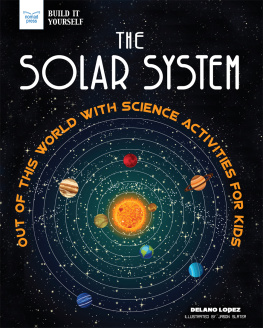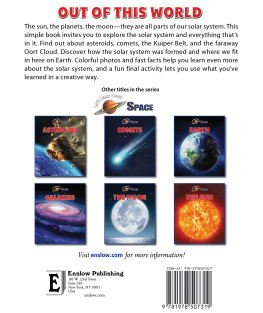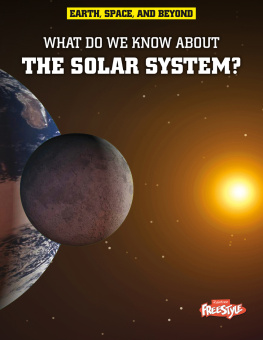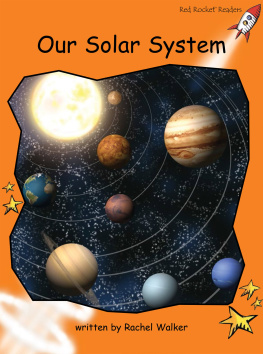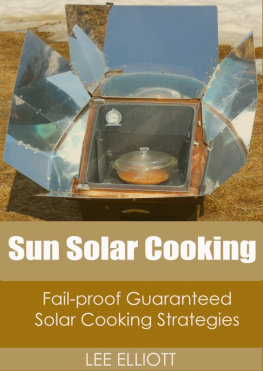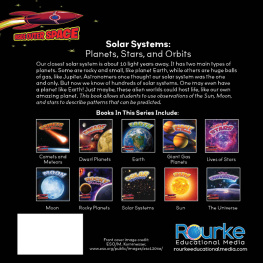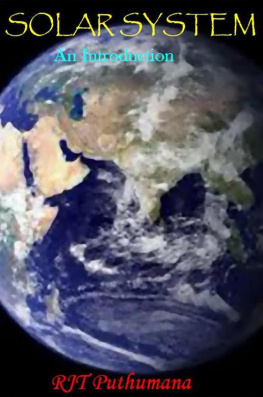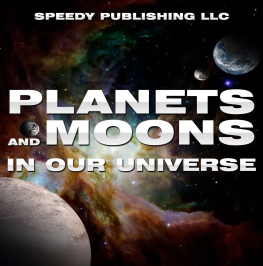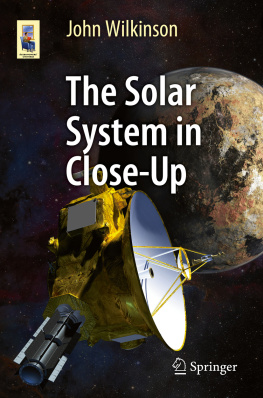Solar System! A Kids Book About the Solar System - Fun Facts & Pictures About Space, Planets & More
Alexander G. Michaels
Table of Contents
The Origin of the Solar System

The Sun is the heart of our Solar System. All of bodies in the Solar System including planets, comets and asteroids revolve around it. The Solar System is made up of the Sun and eight planets and their moons. When we gaze up at the sky at night we see many moving points of lights that move among the stars. These wandering stars are planets.

Our solar system began 4.6 billion years ago. Scientists believe that the solar system was formed when a cloud of dust and gas was disturbed perhaps by a supernova or the explosion of a nearby star. The explosion caused waves in space, which squeezed clouds of dust and gas. Gravity pulled the gas and dust together causing the cloud to collapse into a solar nebula. The cloud spun and got denser and hotter in the center. A disk of dust and gas surrounding it was cool around the edges but hot in the center. As the disk got thinner and thinner, particles and clumps stuck together to form planets or moons. Planets like Earth, made of rocky material, formed near the center of the cloud. Planets like Jupiter formed near the outer regions where icy matter settled. The center got so hot that it turned into a star, the Sun!

It took millions of years for the planets to form. Each planet was the result of varying collisions of balls of ice and rock. The formations that never got big enough to turn into planets became asteroids. The biggest part of our solar system is the Sun followed by Jupiter.
The four planets closest to the sun are called terrestrial planets because they have rocky surfaces. Mars, Earth, Venus and Mercury are called the terrestrial planets. They are made of metal and rock.
The four large planets beyond Mars are called gas giants. Saturn and Jupiter are the largest two planets and are composed of helium and hydrogen.
The two furthest planets are Uranus and Neptune. They are known as ice giants because they are composed of ices like ammonia, water, and methane.
The Solar System also has smaller objects like dwarf planets, comets and interplanetary dust!
Our Solar System is part of the Milky Way galaxy, which contains 200 billion stars.

Majestic Milky Way Galaxy
What's It Made Of?
The Sun is the principal component of the Solar System. The Sun is also called a G-Type Main-Sequence Star! Each second, it converts approximately 600 million tons of hydrogen to helium. The Sun contains 99.86% of our systems mass and is composed primarily of hydrogen and helium. Jupiter and Saturn comprise nearly all of the remaining matter in our solar system and are also made of hydrogen and helium.
The objects of the inner Solar System are composed mostly of rock such as iron and nickel. Jupiter and Saturn are composed mainly of gases such as hydrogen, helium and neon. Ices like water, ammonia, methane, hydrogen sulfide and carbon dioxide are also found in various places in the Solar System. Icy substances comprise the majority of the satellites of the giant planets as well as most of our ice giants, Neptune and Uranus.

A gas giant planet with a system of planetary rings and shepherd moons.
Inner Solar System
Mercury
Mercury is the smallest planet and the closest to our Sun in our Solar System. It is heavily cratered and looks very similar to the moon! Craters were created when comets and asteroids bombed Mercury during its formation. Mercury also has gentle, rolling plains and cliffs. Mercury either freezes or bakes, depending on which side is lit by the Sun! Temperatures can reach 950 degrees F (510 degrees C). The dark side can be as cold as minus 346 degrees F (minus 210 degrees C).

Mercury
Venus

Venus is the second planet from the Sun. Earth and Venus are often called twins because they are similar in mass, density, size, gravity and composition. Venus is the hottest world in the Solar System. Temperatures on Venus reach 800 degrees F (465 degrees C), which is hot enough to melt lead! Venus is dry because of the intense heat. About two-thirds of the surfaces are plains with thousands of volcanoes covering the surface.
Venus
Earth
Earth is the third planet from the Sun and the fifth largest of the eight planets in the Solar System. It was formed approximately 4.54 billion years ago. Earth is an ocean planet and is the only planet that has liquid water on its surface. Our abundance of water and life make it unique in our Solar System. It is the only planet known to possess life! Earth is home to 8.7 million species of life including humans! It is the only planet that has an atmosphere containing 21% oxygen. Earth is the only inner planet to have one large satellite, the Moon.

Glowing Earth surrounded by nebula. Elements furnished by NASA
Mars
Mars is the fourth planet from the Sun and is the second smallest in the Solar System. Mars is red because it is rusty. Theres lots of iron in the soil and Mar's air causes it to turn red like rusty iron on Earth. With a diameter a little over half of Earth, it is the only planet smaller than Mercury. The poles of Mars are covered in ice like on Earth. Mars is the only planet whose surface can be seen in great detail from Earth.

Mars
Outer Solar System
The Outer Solar System is home the gas giants and their moons. This region is further from the Sun and contains objects made of methane, water and ammonia. The four outer planets make up 99% of the mass orbiting the Sun.
Jupiter
Jupiter is the largest of all planets in the Solar System combined. It protects Earth by steering comets towards the sun or pushing them to the outer edges of the Solar System or beyond. Jupiter has dozens of moons orbiting. Its atmosphere resembles the sun and is made up mostly of helium and hydrogen. Do you know that Jupiter is so big that it could hold more than 1,300 Earths?

Jupiter
Saturn
Saturn is the second largest planet and is big enough to hold 760 Earths! Its a gas giant made up of hydrogen and helium. Saturn is known for its extraordinary rings that span up to more than 200 times its diameter! Saturns rings are made up mostly of chunks of dirty ice, particles ranging from small grains to huge boulders even as big as a house! Saturn has at least 62 moons. The largest moon, Titan, is larger than Mercury. Life found on Earth could not live on Saturn and most scientists believe that there is no form of life existing on Saturn.
Next page

